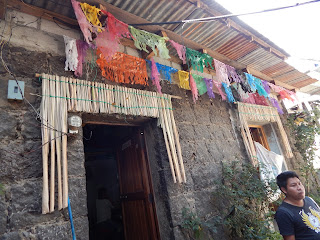I was recently in Central America with Overseas AdventureTravel on their trip, Route of the Maya. This is a wonderful trip for anyone
wanting to explore Central America for the first time. For me however, it was
my fourth time back there, and my goal was to finish seeing the rest of the
Central American countries I had not seen. It was
a surprise to me that they felt complemented that I wanted to return. They are
a kind and gracious people, so if they were complemented in this way, I was
more than happy to oblige.
Before joining the tour, I spent
nine nights in Nicaragua using different tour providers from bookings
I had made on Viator.com. In El Salvador, where I also spent an additional four
nights before joining the group, I used two providers, one of which was El
Salvadorian Tours. Seeing these countries in this fashion provided the
opportunity to get different points of view, from tour guides with different levels
of experience, education, and cultural backgrounds. It also prevented me from getting
“tour fatigue,” which I often feel on organized group tours.
 |
| Photos: Jann Segal |
This contradiction continued as I worked my way to El Salvador and toured for four days before joining the group. I took my own pre-trip of the Flower Route, which OAT offers on many departures. It is a worthy few days to spend whether with OAT or on your own. While on the Flower Route, I visited the town of Suchitoto, which is very near another town memorable during their civil war, Cinquera. I confess that I was taken aback by seeing bombshell casings outside of the church in Cinquera. They are used as church bells these days, since the original church bells were destroyed in the civil war. There are other remnants of the war in the town, including bullet holes, which can be seen in several other San Salvadorian and Nicaraguan towns. In Cinquera, US planes that were shot down are near this house of worship and fenced in by railings that hold M-16s. Yet amid this backdrop, a quiet life continues, and people take Chicken Busses and go on about their lives. There was a celebration in town that day, and ironically, it sounded like I was hearing strains of the Beatles song, “oh, bla de, oh bla da life goes on…” For indeed, life does go on amid the contradictions. “Screams of paradise” pretty well sums up the dichotomy, as described in the song El Salvador by Peter, Paul and Mary, written during the height of their war. It is an extremely powerful song, especially after having been to the country and met the people.
El Salvador by Peter, Paul and Mary (full screen)
Many of
the public squares, which looked so beautiful along the volcanic soil of the
Flower Route, and other parts of El Salvador we visited as part of the OAT tour,
were really public execution sites during their civil war. The people suffer to
this day about the loss of families and lives that the government denies ever
having killed.
As the OAT
tour continued, I observed more contraction, which only intensified as the tour
progressed. One contradiction which struck me was the Mayan ruins themselves.
Only a fraction of them have been unearthed. When we were at Joya de Ceren in
El Salvador, we learned that we were really many miles from the heart of those
Mayan ruins, the majority of which they cannot unearth. It is ironic because for
as much as they want to preserve Mayan culture, they cannot to the fullest
extent. The wind, rain, and other elements of nature are slowly destroying the
ruins that have been discovered. So when archeologists discover an excavation site,
they dig it up, only to bury it again in order to preserve it.
Read more here on the paradox of Latin America
Contradictions abound
as I think of my week in Guatemala. The Mayan culture – not dead at all,
although many will say it is – is still so strong in some villages, that the
church needs to cater to what they consider to be both the Mayan "pagan"
rituals as well as the Christian and Catholic rituals. And in a small
town across the lake from Panajachel, you will find shamans as well as
churches, and people who go to both. The churches there are tolerant of this
paradox and allow it in order to keep the Mayans in the fold and attending
church. We visited one church where we saw images on the pulpit of both
Christianity as well as Mayan culture.
There is
no “ultimate paradox” that I could see in Central America. It was all filled with
one paradox after another. Antigua itself, surrounded by volcanoes and filled with
seismic activity, is perhaps one of the most beautiful Spanish colonial cities
in all of Central America. Yet it has
ruins amidst the beauty of the colonial architecture, and has been leveled so many
times over the years, that seeing vestiges of the many ruins is part of the experience
of Antigua. Its history is complex as well, and if you Google Central American contradictions
as I did while writing this article, you will see that much has been written about
the region in this regard.
Like any
other part of the world that is worthy of your time and money, Central America
and all its apparent contradictions and paradoxes in all their forms, just adds
to the fascination.
Read more here on the paradox of Latin America



No comments:
Post a Comment